
The Beauty to Bonsai Garden Design
Published: 23/03/2023 | Updated: 24/04/2023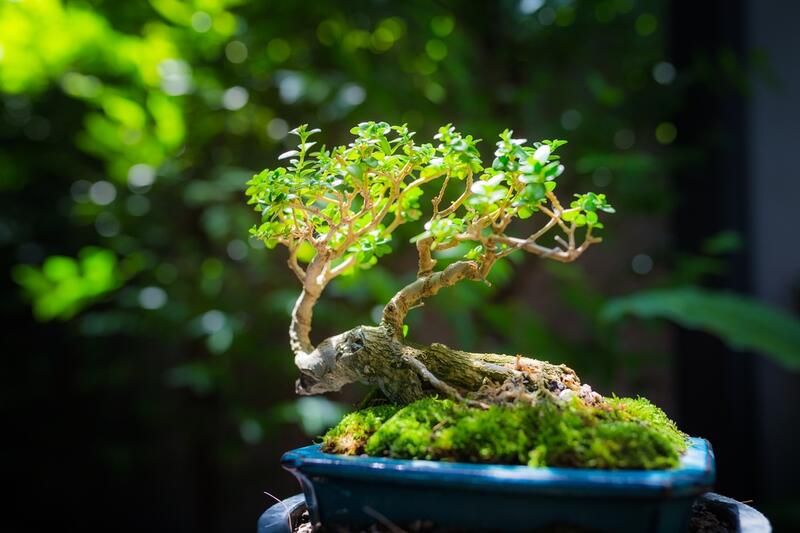
More than anything else, a well-designed bonsai garden makes your trees stand out. But creating one is quite challenging, particularly since you must figure out how to display your trees at eye level while taking into account the unique needs of each of your trees.


On the hottest days, some trees will need at least some partial shade, but other trees enjoy as much sun as possible. The majority of professional bonsai gardens include shade-cloth systems that may be employed in the summer and produce variable quantities of shadow. Good luck! This article should provide you with some ideas and practical starting point advice.
What Are Bonsai Trees?
Trees and plants that have been trained to look even more lovely than those that would naturally grow in the wild are known as bonsai. As a result, growing bonsai is both a traditional Japanese art and a very creative hobby. It also serves as a fantastic example of the delicate respect that Japanese people have for all living things and a manifestation of their appreciation of beauty. It involves a lot more work and calls for a greater mental and physical commitment than producing flowers in pots.
Although the term "bonsai" was first used in a poem in the middle of the fourteenth century, earlier examples of bonsai culture may be found in picture scrolls from as early as 1309. Around three centuries later, during the Edo era, it was more extensively embraced (1603–1867).
Types of Bonsai Trees
As bonsai, a variety of trees and shrubs are used. A bonsai can be made from any plant that can be grown in a small container. The most well-liked kinds include shohaku pines, quince, and persimmon trees, cherry and plum trees, maples, which change color in the fall, and flowering trees like cherry and plum. Varieties that are most suited to the local climate are employed in nations other than Japan. The trees can reach heights of up to one meter (3.3 feet), or they can be as little as a human hand.
There are various fundamental bonsai styles. Shakan-style trees have a slanted trunk that leans to one side; moyogi-type trees have a curved S-shaped trunk. Chokkan-style bonsai trees have a trunk that grows straight upward with branches that extend left, right, front, and behind in a well-balanced manner. Kengai style refers to a tree that curves downhill and is found in regions with steep slopes, such as cliffs, whereas the fukinagashi style depicts a tree that is molded by powerful winds, with bent trunks and branches growing in one direction.
The most crucial thing to remember is to let the tree express its uniqueness without pressuring it to fit into any particular category and to assist it in achieving its most beautiful, balanced form. All varieties of bonsai trees have a tree shape that tends to suit them best.
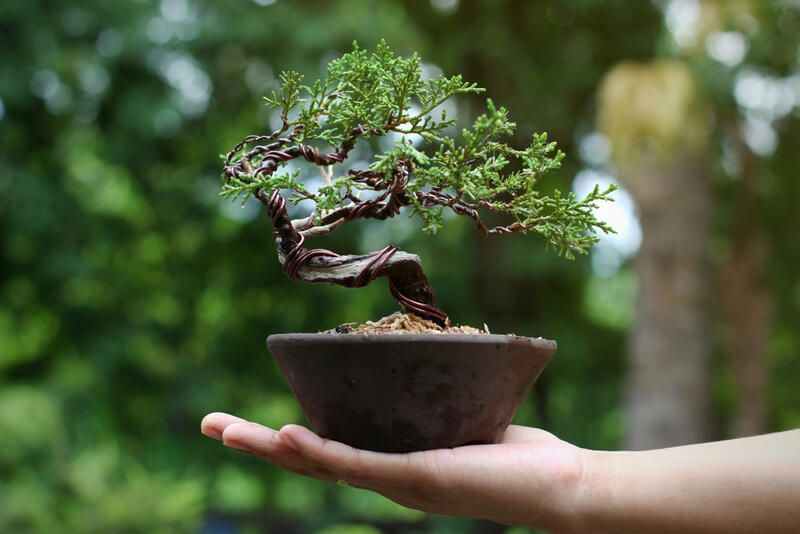
How to Landscape Bonsai Trees
The bonsai tree you pick for your landscape design should not only match well with the rest of your garden's design, but it also needs to be in good health. To be a successful focus of a landscape design, the tree needs to be properly fed, watered, trained, and re-potted.
Materials You'll Need
-
Bonsai Tree
-
Any bonsai grower that participates in landscape design has the opportunity to showcase his abilities. Use your best, healthiest, and most properly trained bonsai for this guide. Avoid including your bonsai in a landscaping plan if it hasn't been trained and shaped completely.
-
-
Bonsai Pot
-
Your bonsai pot ought to blend in with the general design since you'll be including it in a landscape. For bonsai cultivation, there are numerous pots available, each with a unique shape, depth, width, color, and material. Use jade pots if you're making a garden with a Japanese theme. This particular pot is referred to as the traditional Japanese bonsai pot. These are offered by neighborhood nurseries as well as by offline and online bonsai gardening stores.
-
-
Bonsai Potting Soil
-
Garden centers and bonsai nurseries sell potting soil that is perfect for bonsai cultivation. To avoid nutrient toxicity and root rot, the optimum potting soil can contain a lot of water and nutrients while also draining extra water and fertilizer.
-
-
Aggregates
-
Utilizing aggregates will help your soil's drainage and aeration abilities. The bottom of the pot is filled with very little bits of rock and stuff. In addition to allowing excess water to drain, aggregate materials also allow oxygen to reach the soil, feeding the roots. Local garden supply stores and bonsai nurseries both sell aggregate materials.
-
-
Rocks
-
Rocks are a natural addition to a landscape design that enhances it. There are many different types of rocks to use, but in a garden setting, big, clear boulders with well-defined surfaces are typically employed. You can utilize pebbles from your backyard or neighborhood, or you can buy them from a nearby garden shop or store.
-
-
Fertilizer (Well Balanced)
-
A balanced fertilizer that can offer the ideal ratios of nutrients is the type that is most frequently employed. But you need to do your homework; choose the kind of fertilizer that will help your tree at its particular stage of growth. You can get balanced fertilizer from internet stores or a nearby store that sells bonsai materials and accessories.
-
-
Water
-
To water your bonsai plants, they must be clean and safe. If the water is clean and won't endanger your plants, you can use either tap water or rainwater. Before using this on your bonsai, have the purity and safety of your water evaluated.
-
-
Wire
-
To arrange your bonsai according to the bonsai style you wish to achieve, you need wire. The two most widely used types of wires are annealed copper and aluminum. For bonsai with young, malleable branches, use aluminum wires. For larger and thicker branches and trunks, use annealed copper. Additionally, wires come in a variety of gauges that range in thickness from 1 mm to 4 mm.
-
-
Pilers
-
You will need a decent pair of pliers to cut the wire and take them off after training is finished. For working with thick roots, branches, and trunks on mature trees, a good pair of pliers is also required.
-
-
Pruning Shears
-
You can gently prune and trim your bonsai with pruning shears to obtain the style you desire. Although there are many different kinds of pruning shears, you should always use clean or sanitized shears to stop the spread of bacteria or mold.
-
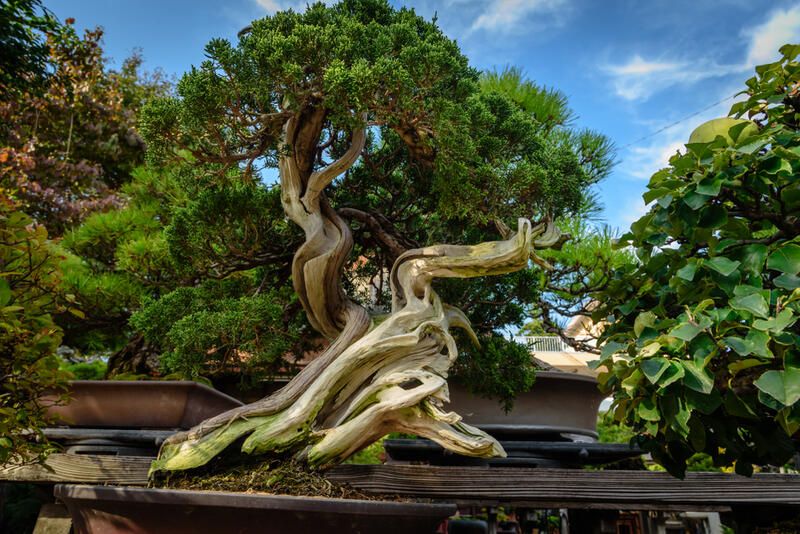
Planning Landscaping Design
The overall landscape design must be carefully planned. The goal of landscaping is to combine other materials required for a landscape design with natural elements such as trees, grass, plants, water, soil, and rocks. For example, you might wish to include bonsai in the landscaping of a patio, a poolside area, or a Zen garden-style meditation space. Here are some strategies to aid you in producing the design you desire:
-
Think about how big the area is that you will be working in. You may develop a landscaping plan for a tiny patio or a sizable backyard.
-
Take a look at the area's immovable natural features. These consist of trees, ground-based plants, outdoor structures like your garage, a pool, a fish pond, water fountains, grottos, etc. You must take into account everything, not just where to place your bonsai tree, to establish a sense of harmony in the environment. Additionally, taking these factors into account will help you choose the type of bonsai tree to add to your landscape design as well as the best location for the tree in your garden.
-
Take into account the surrounding environment when planning your landscape.
When including bonsai in any landscaping design, this is crucial. Because bonsai are extremely sensitive plants, they require the correct growing conditions to flourish. Additionally, because your bonsai will serve as the focal point of your design, it should be growing well despite being grown outdoors. It is therefore quite important to think about the right bonsai to grow in the environment where the new landscaping would be put.
Choosing Rocks for Landscaping
Most bonsai gardeners employ other natural features like rocks to establish this focus, which is created by placing a strong emphasis on the bonsai tree or trees in a garden. The gardener typically employs rocks, which come in a variety of sizes and forms, to construct some sort of narrative or message.
Large and tiny rocks are frequently used in bonsai gardens. Each bonsai tree is typically surrounded by small, pebble-sized rocks, while larger boulders are used as supplementary garden focal points.
Large rocks typically have a form that is more vertical than horizontal. The top-heaviness of these big, vertical rocks will likewise increase. In a bonsai garden, rock qualities are important. The focal rocks in a bonsai garden landscape will typically have a narrower base than a wider top. Rocks ought to have a pleasing appearance.
Choose rocks with vertical cracks because even in different rock formations, these are more likely to allow bonsai roots to grow onto the rock. Black, grey, white, brown, or red rocks should be the ones you choose for your bonsai landscape. Never use moss-covered rocks since the bonsai trees won't be able to stand out from them.
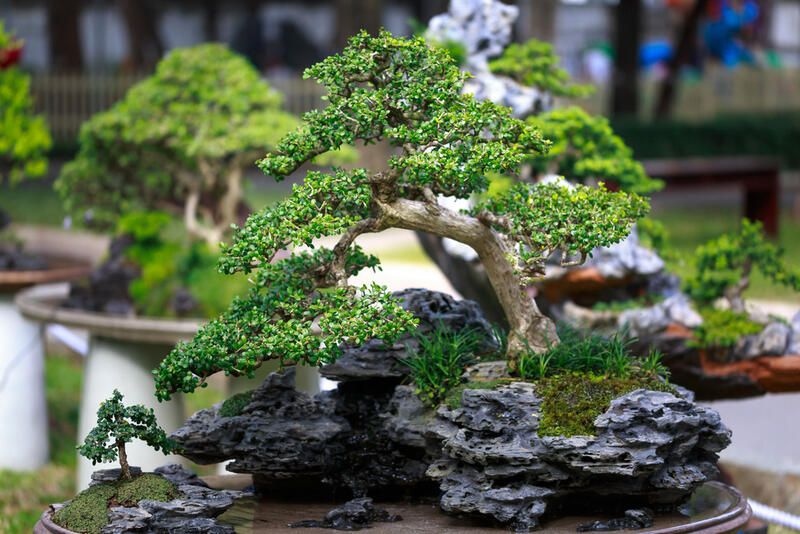
Preparing Bonsai Trees
Consider using these methods if your bonsai isn't quite ready to be a part of your landscaping. Plant health, strength, and general development are all readiness factors.
-
Shaping the Roots
-
Cultivating the Root System
-
Reconstructing the Root System
-
Pruning the Subsurface Roots & Tap Roots
-
Pruning Seedlings
-
Root Pruning for Established Plants
-
Pruning the Tap Root
Wiring Shapes
You may regulate your tree's development by using wiring. It is positioned around a growing trunk and branches to direct their development into the desired shape. Once the tree's roots are well-established and the trunk is beginning to form, wiring can begin. Wiring is a continuous process that is carried out in phases and with numerous branches.
The trunk and branches' growth can be regulated using wiring. Because wiring enables you to shape the tree artistically, it also has aesthetic benefits. By doing this, the bonsai will become more attractive in ways that would not be conceivable if the tree were allowed to develop organically.
Choosing a Style for Your Bonsai Garden
Determine whether a particular kind of bonsai tree will be used in your landscape design after selecting the correct rock formation. Will the landscape have bonsai trees in the half-cascade, windswept, or semi-cascade styles? There is no set guideline for which style should be employed or which styles complement one another the best, but you must have a sense of harmony and balance. Pick the design that will complement your landscape the best.
Several things to think about If you have an artificial water element that resembles a miniature waterfall use a tilted or cascading bonsai design. To give the impression that these were grown in the environment naturally, you might arrange cascading bonsais close to the water feature.
Another concept is to place a Zen Garden feature in the middle of a literati or broom style. The centerpiece of this straightforward yet soothing design might be a healthy, green bonsai tree.
Examples of Shapes Include:
-
Broom style (hokidachi)
-
Formal upright (chokkan)
-
Slanting bonsai style (shaken)
-
Informal upright (moyogi)
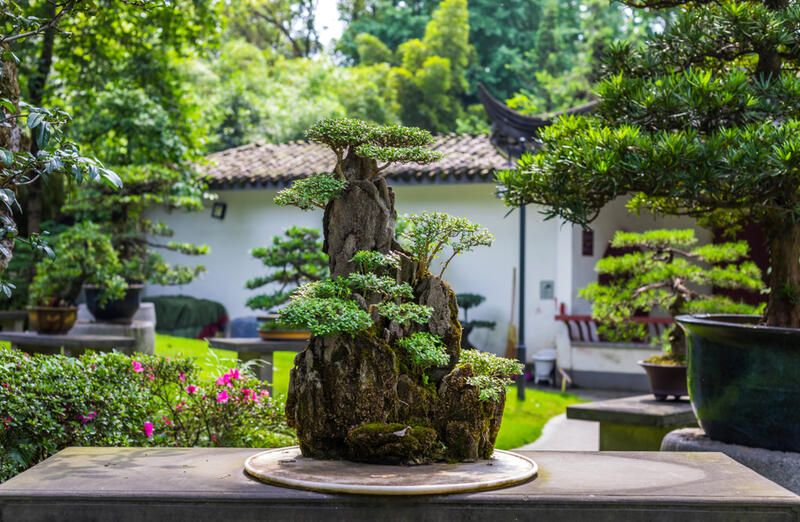
Arranging Your Bonsai Trees
You must arrange the appropriate rocks and the ideal bonsai shape or design in your landscaping area now that you have them for your bonsai landscape. Consider positioning the rocks and trees to produce an equal amount of free and filled area for aesthetic purposes. Never arrange small pieces and tall elements next to one another. Here are some ideas to think about.
To accentuate your bonsai tree, create a Zen Garden. A Zen Garden typically has a simple layout with bamboo panels or fences, water, lighting, pebbles, stones, sand, or fine gravel. In addition to being a wonderful spot in your yard, this landscape design can be used for meditation and relaxation.
Display bonsai designs with the use of water features. Use a cascading water feature's focal point to be a bonsai. Use cascading bonsai near cliffs and steep rocks, or place bonsai close to a fountain or waterfall.
An educational experience is creating a bonsai garden. By constructing and organizing various parts of your garden, you will get knowledge about how to create this garden environment. Don't be scared to play around with different arrangements and styles.
Maintenance for Bonsai Plants
Your bonsai trees must be carefully pruned to keep their desired shapes once they have been positioned and arranged. The chosen bonsai tree styles and the requirements for each specific kind of tree must be taken into consideration when maintaining a bonsai.
You should establish a strict plan for your pruning, trimming, and pinching because some trees only need to be pruned once a year while others may need trimming seasonally.
If you intend to keep your bonsai outside, make sure to water it frequently and keep the soil damp. However, as bonsai are more vulnerable to mold and root rot while they are outdoors, water only when the soil is dry.
As necessary, give your bonsai food. For information on when, how, and how much to feed your trees, always refer to the manufacturer's instructions. When it comes to feeding your plants, never forget to consider the type of tree and its stage of development.
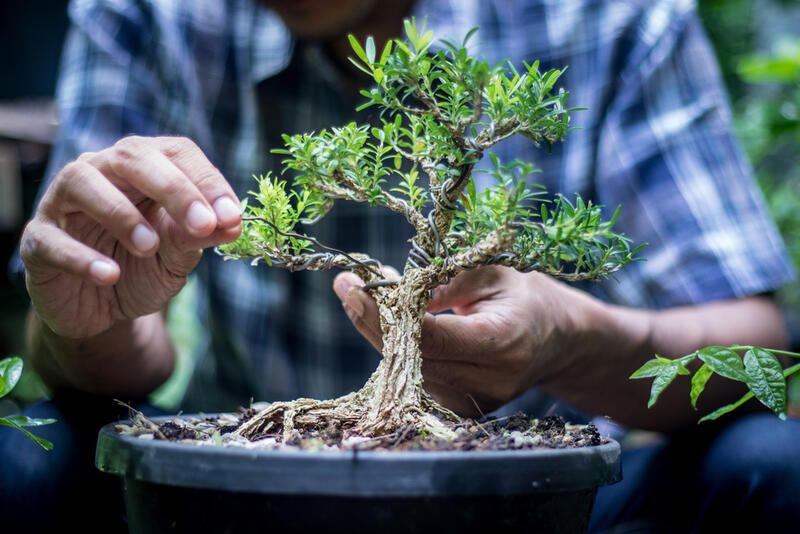
Adding Other Elements
If you'd like, you can add additional components to your bonsai landscaping to bring out the best in the surrounding trees and rocks. Water features like miniature waterfalls, fountains, or ponds with live fish are options you might include. Other outside additions like lighting, chairs, lamps, canopies and other fixtures are also an option.
Using Vertical Poles
Professional Bonsai gardens (including Japanese Bonsai gardens) frequently place their most significant trees on poles in the center of the garden for display. The trees shine out more when they are positioned at eye level, allowing people to admire them while exploring the area.
The main challenge is selecting materials because positioning the poles is rather simple. Old railroad ties or tree trunks made of wood, stone slabs, and concrete pillars have all been encountered. Let's look at different gardens where bonsai are exhibited on poles for ideas.
Get to Planning & Planting!
Bonsai are included in a landscape design after considerable consideration. You must start preparing your trees early if you plan to create a bonsai garden in the future. Prepare your landscape design plans and choose the bonsai tree kind, shape, and style you want to utilize.
Always contact a professional if you feel overwhelmed, we recommend you try out Shrubhub.com for a free plant consultation!
By trimming, pinching, wiring, and improving the health of your trees, you may get your trees ready early. Pick a look or pattern that works with your landscape designs. Finally, once everything is established in your bonsai garden, don't forget to care for your bonsai as well as every other component.


